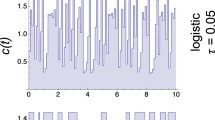Abstract
Studying populations, be it a microbe colony or mankind, is important for understanding how complex systems evolve and exist. Such knowledge also often provides insights into evolution, history and different aspects of human life. By and large, populations’ prosperity and decline is about transformation of certain resources into quantity and other characteristics of populations through growth, replication, expansion and acquisition of resources. We introduce a general model of population change, applicable to different types of populations, which interconnects numerous factors influencing population dynamics, such as nutrient influx and nutrient consumption, reproduction period, reproduction rate, etc. It is also possible to take into account specific growth features of individual organisms. We considered two recently discovered distinct growth scenarios: first, when organisms do not change their grown mass regardless of nutrients availability, and the second when organisms can reduce their grown mass by several times in a nutritionally poor environment. We found that nutrient supply and reproduction period are two major factors influencing the shape of population growth curves. There is also a difference in population dynamics between these two groups. Organisms belonging to the second group are significantly more adaptive to reduction of nutrients and far more resistant to extinction. Also, such organisms have substantially more frequent and lesser in amplitude fluctuations of population quantity for the same periodic nutrient supply (compared to the first group). Proposed model allows adequately describing virtually any possible growth scenario, including complex ones with periodic and irregular nutrient supply and other changing parameters, which present approaches cannot do.





Similar content being viewed by others
References
Blount ZD, Boreland CZ, Lenski RE (2008) Historical contingency and the evolution of a key innovation in an experimental population of Escherichia coli. Proc Natl Acad Sci USA 105:7899–7906
Chester MA (2012) Fundamental principle governing populations. Acta Biotheor 60:289–302
Crow JA (1971) The epic of Latin America. Doubleday & Company Inc, New York
Fantes PA (1977) Control of cell size and cycle time in Schizosaccharomyces pombe. J Cell Sci 24:51–67
Jorgensen P, Tyers M (2004) How cells coordinate growth and division. Curr Biol 14:1014–1027
Maaloe O, Kjeldgaard NO (1966) Control of macromolecular synthesis; a study of DNA, RNA, and protein synthesis in bacteria. W. A. Benjamin, New York
Matos MP (2011) Dynamics, games and science II. Springer-Verlag, Berlin
Neal D (2004) Introduction to population biology. Cambridge University Press, Cambridge
Nebel BJ, Wright RT (1993) Environmental science: the way the world works. Prentice-Hall, Englewood Cliffs, NJ
Pramanik J, Keasling JD (1997) Stoichiometric model of Escherichia coli metabolism: incorporation of growth-rate dependent biomass composition and mechanistic energy requirements. Biotechnol Bioeng 56:398–421
Shestopaloff YK (2012a) General law of growth and replication, growth equation and its applications. Biophys Rev Lett 7(1, 2):71–120
Shestopaloff YK (2012b) Growth and replication of living organisms. General law of growth and replication and the unity of biochemical and physical mechanisms, 2nd edn. AKVY Press, Toronto
Shestopaloff YK (2012c) Predicting growth and finding biomass production using the general growth mechanism. Biophys Rev Lett 7(3):177–195
Shestopaloff AY, Neal RM (2013) MCMC for non-linear state space models using ensembles of latent sequences. http://www.utstat.toronto.edu/~alexander/
Sveiczer A, Novak B, Mitchison JM (1996) The size control of fission yeast revisited. J Cell Sci 109:2947–2957
Thieme HR (2003) Mathematics in population biology (Princeton Serious in mathematical and computational biology). Princeton University Press, Princeton, NJ
Acknowledgments
The author thanks Alexander Shestopaloff for discussions, feedback and editing efforts, and reviewers for valuable comments.
Author information
Authors and Affiliations
Corresponding author
Appendix: Method’s Stability
Appendix: Method’s Stability
From a mathematical perspective, stability of a proposed dynamic population model based on (8) and (9) can be evaluated through a full differential dN expressed through partial derivatives as follows.
For small finite errors \(\delta N,\delta t,\delta r,\delta T\) we can rewrite (21) as follows.
We assume that differentiable one-to-one functions \(t = t(r)\) and \(t = t(T)\) exist. For our purposes, this is a realistic and not restrictive assumption. Then, using these substitutions, we can directly obtain derivative of an integral over the upper integration limit for r and T. Substituting into the above equation derivatives of right side of (8) on t, r and T, and doing appropriate transformations, we eventually obtain the following formula (here, an apostrophe means the first derivative).
Given the fact that \(t^{\prime } (r) = \frac{dt}{dr} \approx \frac{\Updelta t}{\Updelta r}\), we can write \(t^{\prime } (r)\delta r \le K\frac{\Updelta t}{\Updelta r}\delta r\). Since both \(\delta r\) and \(\Updelta r\) are finite, we can assume that \(\delta r = L\Updelta r\) (here, K and L are positive numbers, symbol \(\Updelta\) denotes small finite increment), so that \(t^{\prime } (r)\,\delta r \le K\frac{\Updelta t}{\Updelta r}\delta r = K\frac{\Updelta t}{\Updelta r}L\Updelta r = KL\Updelta t.\) In other words, the error in evaluation of population quantity introduced by the reproduction rate is of the same order as the error introduced by inaccurate time (although, of course, \(\delta t\) and \(\Updelta t\) can be different). Similarly, we can show that the same is true for error introduced by imprecision of a reproduction period, that is it is of the same order as the error introduced by inaccurate time.
Thus, if we associate differentials with errors of appropriate parameters (which is the usual approach), then we can see that the error of evaluation of population quantity continuously depends on errors of parameters, so that when parameters’ errors go to zero, the error of evaluation of population quantity goes to zero as well (assuming that \(rN\ln 2/T\) in (22) is finite, which is always fulfilled for finite reproduction periods). Overall, this proves mathematical stability of the proposed population growth model.
Rights and permissions
About this article
Cite this article
Shestopaloff, Y.K. A General Method for Modeling Population Dynamics and Its Applications. Acta Biotheor 61, 499–519 (2013). https://doi.org/10.1007/s10441-013-9202-8
Received:
Accepted:
Published:
Issue Date:
DOI: https://doi.org/10.1007/s10441-013-9202-8




